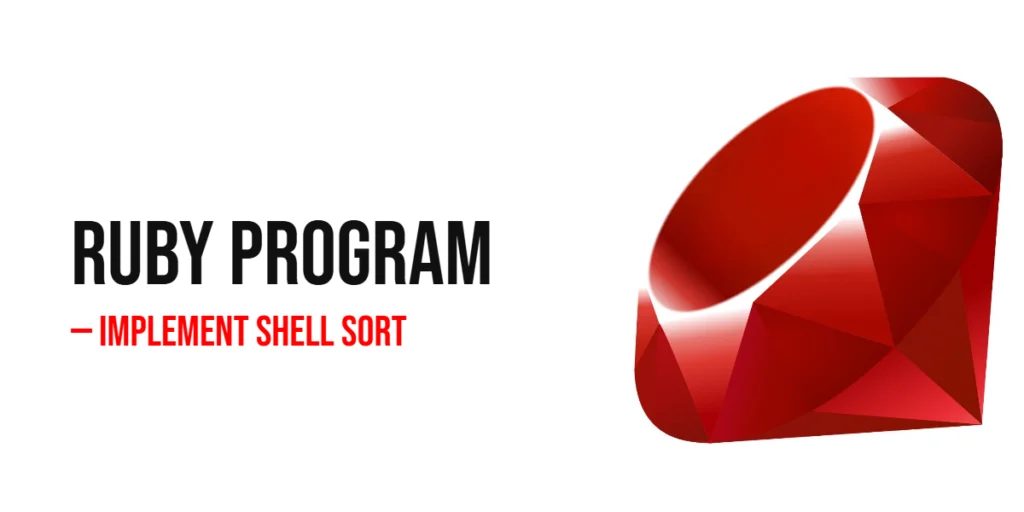Sorting is an essential part of programming because it helps us organize data for easier searching, analysis, and processing. Among the various sorting algorithms, Shell Sort is a fascinating and practical choice. It is an improvement over Insertion Sort that allows the exchange of items far apart, which reduces the total number of movements. The algorithm works by comparing elements separated by a “gap” and gradually reducing this gap until it becomes 1, at which point it behaves like a standard Insertion Sort.

with hands-on learning.
get the skills and confidence to land your next move.
Shell Sort is particularly useful in applications where datasets are moderately large, and performance is important but simplicity is also desired. Learning Shell Sort in Ruby helps beginners understand concepts like gap-based sorting, incremental improvement, and efficiency optimization. In this article, we will explore multiple ways to implement Shell Sort in Ruby, including ascending and descending order, loop-based and recursive approaches, and an optimized version using the Knuth gap sequence. By the end, beginners will clearly understand how this algorithm works and how to apply it effectively.
Program 1: Shell Sort Using Loops (Ascending Order)
This first program demonstrates the classic loop-based Shell Sort to sort a predefined array of integers in ascending order.
# Program 1: Shell Sort using loops (ascending)
def shell_sort(array)
n = array.length
gap = n / 2
while gap > 0
(gap...n).each do |i|
temp = array[i]
j = i
while j >= gap && array[j - gap] > temp
array[j] = array[j - gap]
j -= gap
end
array[j] = temp
end
gap /= 2
end
array
end
numbers = [12, 34, 54, 2, 3]
sorted_array = shell_sort(numbers)
puts "Sorted array: #{sorted_array}"In this program, the initial gap is set to half the array length and reduces by half in each iteration. Elements separated by the gap are compared and swapped if necessary, allowing elements to move closer to their final position quickly. Beginners can see that Shell Sort combines the simplicity of Insertion Sort with the efficiency of gap-based sorting, making it a practical algorithm for real datasets.
Program 2: Shell Sort in Descending Order
Shell Sort can be easily modified to sort in descending order by reversing the comparison condition.
# Program 2: Shell Sort descending order
def shell_sort_desc(array)
n = array.length
gap = n / 2
while gap > 0
(gap...n).each do |i|
temp = array[i]
j = i
while j >= gap && array[j - gap] < temp
array[j] = array[j - gap]
j -= gap
end
array[j] = temp
end
gap /= 2
end
array
end
numbers = [19, 2, 31, 45, 6, 11]
sorted_array = shell_sort_desc(numbers)
puts "Sorted array (descending): #{sorted_array}"By changing the comparison from > to <, the algorithm sorts elements from largest to smallest. Beginners can understand that Shell Sort’s core logic remains the same, and minor adjustments control the sorting order effectively.
Program 3: Shell Sort for Floating-Point Numbers
Shell Sort works with floating-point numbers as well. This example demonstrates sorting a predefined array of floating-point numbers.
# Program 3: Shell Sort for floating-point numbers
def shell_sort_floats(array)
n = array.length
gap = n / 2
while gap > 0
(gap...n).each do |i|
temp = array[i]
j = i
while j >= gap && array[j - gap] > temp
array[j] = array[j - gap]
j -= gap
end
array[j] = temp
end
gap /= 2
end
array
end
numbers = [0.45, 0.12, 0.78, 0.32, 0.65]
sorted_array = shell_sort_floats(numbers)
puts "Sorted floats: #{sorted_array}"This example shows the versatility of Shell Sort, as it can handle both integers and decimal numbers without changing the core logic. Beginners can appreciate that the algorithm is based on comparisons and not the type of numeric data.
Program 4: Shell Sort Using Recursion
Shell Sort can also be implemented recursively, where each reduced gap level is processed through a recursive function call. This approach reinforces recursion concepts for beginners.
# Program 4: Recursive Shell Sort
def shell_sort_recursive(array, gap = nil)
gap ||= array.length / 2
return array if gap < 1
(gap...array.length).each do |i|
temp = array[i]
j = i
while j >= gap && array[j - gap] > temp
array[j] = array[j - gap]
j -= gap
end
array[j] = temp
end
shell_sort_recursive(array, gap / 2)
end
numbers = [23, 12, 1, 8, 34, 54, 2, 3]
sorted_array = shell_sort_recursive(numbers)
puts "Sorted array (recursive): #{sorted_array}"In this recursive version, the gap is halved with each recursive call until it reaches 0. Beginners can see how recursion replaces the iterative gap reduction while maintaining the same sorting logic. It also illustrates how recursion can simplify loop-based algorithms conceptually.
Program 5: Optimized Shell Sort Using Knuth Sequence
This version of Shell Sort uses the Knuth gap sequence (gap = gap * 3 + 1) for faster and more efficient sorting on larger arrays.
# Program 5: Optimized Shell Sort using Knuth sequence
def shell_sort_knuth(array)
n = array.length
gap = 1
gap = gap * 3 + 1 while gap < n / 3
while gap > 0
(gap...n).each do |i|
temp = array[i]
j = i
while j >= gap && array[j - gap] > temp
array[j] = array[j - gap]
j -= gap
end
array[j] = temp
end
gap = (gap - 1) / 3
end
array
end
numbers = [23, 12, 1, 8, 34, 54, 2, 3, 7]
sorted_array = shell_sort_knuth(numbers)
puts "Optimized sorted array (Knuth gap): #{sorted_array}"The Knuth sequence spreads out the comparisons more evenly across the array, reducing unnecessary swaps and improving efficiency. Beginners can see that the core Shell Sort logic stays the same, but thoughtful gap selection makes the algorithm faster, especially for larger datasets.
Frequently Asked Questions (FAQ)
Q1: What is the time complexity of Shell Sort?
Shell Sort has a worst-case time complexity of O(n²), but with optimal gap sequences like Knuth’s, it often approaches O(n log n) in practice, making it faster than simple sorts like Bubble or Insertion Sort.
Q2: Is Shell Sort stable?
No, Shell Sort is not stable because swapping elements across gaps can change the relative order of equal elements.
Q3: Can Shell Sort handle floating-point numbers?
Yes, it works for both integers and floating-point numbers because it relies on comparisons rather than data type.
Q4: When should I use Shell Sort?
Shell Sort is useful for moderately sized datasets where simple algorithms like Insertion Sort are too slow. It is easy to implement, requires no extra memory, and can handle numeric and decimal datasets efficiently.
Q5: What is the advantage of the Knuth gap sequence?
The Knuth sequence reduces unnecessary swaps and distributes comparisons more evenly, making Shell Sort faster for larger arrays while maintaining its simple logic.
Conclusion
In this article, we explored multiple ways to implement Shell Sort in Ruby, including loop-based ascending and descending order, sorting floating-point numbers, a recursive approach, and an optimized version using the Knuth gap sequence. Shell Sort is a practical and versatile algorithm that improves upon Insertion Sort by allowing far-apart elements to move closer to their final position quickly. By practicing these examples, beginners will understand gap-based sorting, recursion, and efficiency improvements. Shell Sort is simple to implement, versatile, and an excellent tool for organizing numeric and floating-point datasets efficiently.







